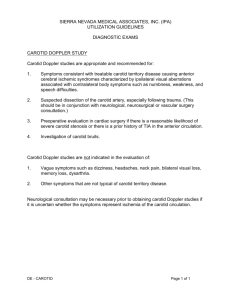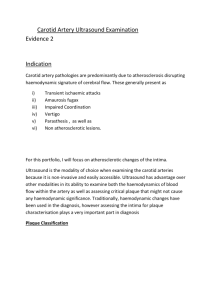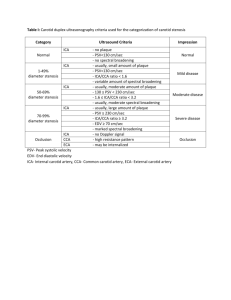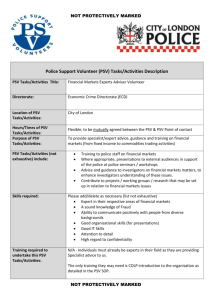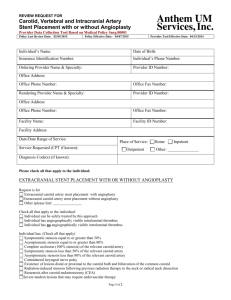Protocol for Performing Extracranial Cerebrovascular Duplex
advertisement
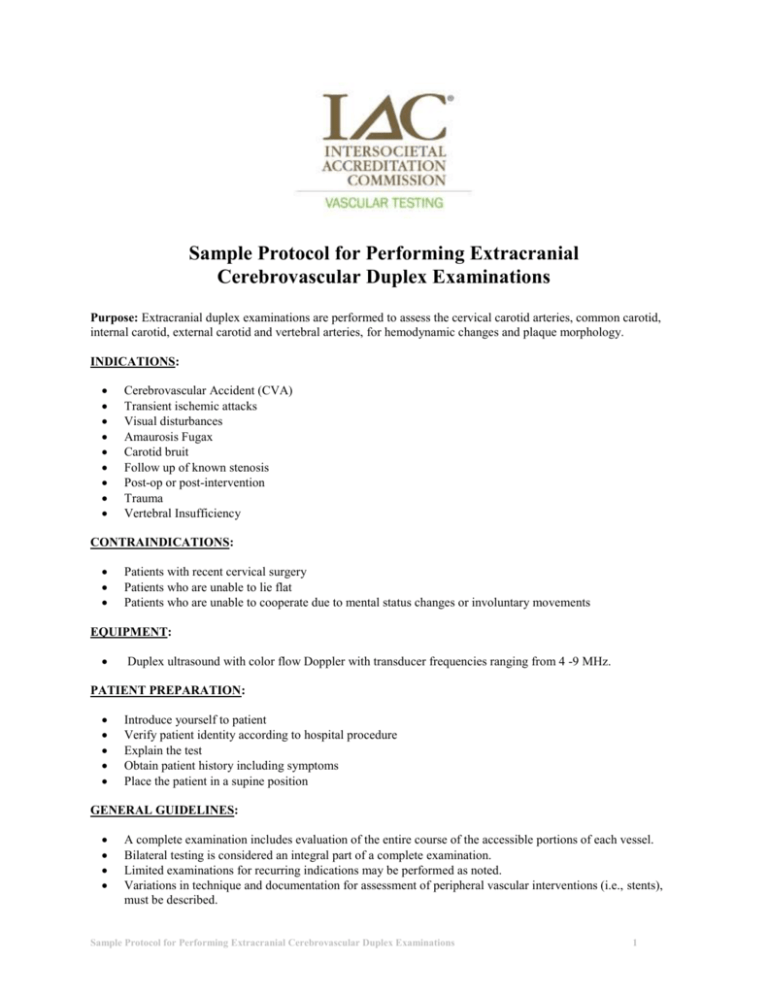
Sample Protocol for Performing Extracranial Cerebrovascular Duplex Examinations Purpose: Extracranial duplex examinations are performed to assess the cervical carotid arteries, common carotid, internal carotid, external carotid and vertebral arteries, for hemodynamic changes and plaque morphology. INDICATIONS: Cerebrovascular Accident (CVA) Transient ischemic attacks Visual disturbances Amaurosis Fugax Carotid bruit Follow up of known stenosis Post-op or post-intervention Trauma Vertebral Insufficiency CONTRAINDICATIONS: Patients with recent cervical surgery Patients who are unable to lie flat Patients who are unable to cooperate due to mental status changes or involuntary movements EQUIPMENT: Duplex ultrasound with color flow Doppler with transducer frequencies ranging from 4 -9 MHz. PATIENT PREPARATION: Introduce yourself to patient Verify patient identity according to hospital procedure Explain the test Obtain patient history including symptoms Place the patient in a supine position GENERAL GUIDELINES: A complete examination includes evaluation of the entire course of the accessible portions of each vessel. Bilateral testing is considered an integral part of a complete examination. Limited examinations for recurring indications may be performed as noted. Variations in technique and documentation for assessment of peripheral vascular interventions (i.e., stents), must be described. Sample Protocol for Performing Extracranial Cerebrovascular Duplex Examinations 1 TECHNIQUE: Equipment gain and display settings will be optimized while imaging vessels with respect to depth, dynamic range and focal zones. Color flow Doppler will be added to supplement B-mode images with proper color scale to demonstrate areas of high flow and color aliasing. Power Doppler will be used to validate low flow states or occlusions. Cursor sample size will be small and positioned parallel to the vessel wall and/or direction of blood flow. A spectral Doppler angle of 60 degrees or less will be used to measure velocities. Spectral Doppler gains will be set to allow a spectral window and optimized to reduce artifact. Areas of suspected stenosis or obstruction will include spectral Doppler waveforms and velocity measurements recorded at and distal to the stenosis or obstruction. Sites of intervention (i.e., stents) will include spectral Doppler waveforms and velocity measurements from the proximal, mid and distal sites. Plaque should be assessed and characterized. DOCUMENTATION: Duplex evaluation is performed bilaterally starting with the right side. Long axis B-mode images must be obtained from: o Common carotid artery (CCA) o Carotid artery bifurcation (if both the internal carotid artery (ICA) and the external carotid artery (ECA) are not visible in one image, take an image of each with the bifurcation) o Internal carotid artery (ICA) Spectral Doppler waveforms and velocity measurements must be documented from: o Proximal CCA peak systolic velocity (PSV) o Mid CCA PSV o Proximal ICA PSV and end diastolic velocity (EDV) o Mid ICA PSV and EDV if stenosis is present o Distal ICA PSV and EDV o ECA PSV (temporal tap may be used to identify) o Vertebral Artery PSV The ICA/CCA ratio should be calculated using a normal CCA PSV and the highest ICA PSV. PROCESSING: Review examination data and process for final interpretation Note study limitations Sample Protocol for Performing Extracranial Cerebrovascular Duplex Examinations 2


